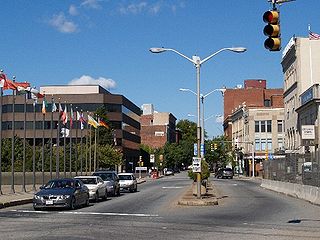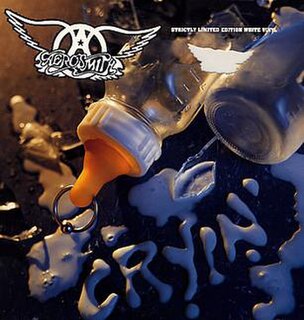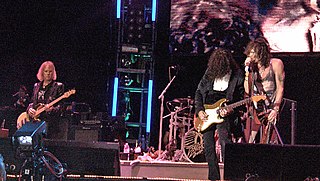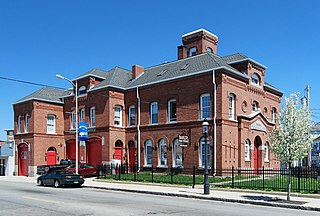E. and G.G. Hook was a pipe organ designing and manufacturing company, located in Boston, Massachusetts, which operated from 1827 to 1935. It was started, and originally run, by brothers Elias and George Greenleaf Hook.
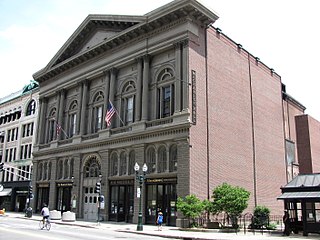
Mechanics Hall is a concert hall in Worcester, Massachusetts. It was built in 1857 in the Renaissance Revival style and restored in 1977. Built as part of the early nineteenth-century worker's improvement movement, it is now a concert and performing arts venue ranked as one of the top four concert halls in North America and in the top twelve between Europe and America. It also houses a recording studio.

Brayton Methodist Episcopal Church is an historic former Methodist church building located at 264 Griffin Street in Fall River, Massachusetts. The wooden Gothic Revival church building was constructed in 1897 through the generosity of John Summerfield Brayton and his sister Mary Brayton Young. It was designed by local architect Charles H. Farnham.
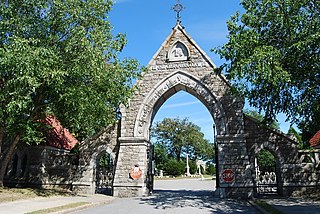
Oak Grove Cemetery is a historic cemetery located at 765 Prospect Street in Fall River, Massachusetts. It was established in 1855 and greatly improved upon in the years that followed. It features Gothic Revival elements, including an elaborate entrance arch constructed of locally quarried Fall River granite. The cemetery originally contained 47 acres, but has since been expanded to roughly 100 acres. The cemetery is the city's most significant, built in the planned rural-garden style of Mount Auburn Cemetery in Cambridge, Massachusetts. It was designed and laid out by local architect Josiah Brown, who is also known for his designs of early mills including the Union, Border City, and others.

For much of its history, the city of Fall River, Massachusetts has been defined by the rise and fall of its cotton textile industry. From its beginnings as a rural outpost of the Plymouth Colony, the city grew to become the largest textile producing center in the United States during the 19th century, with over one hundred mills in operation by 1920. Even with the demise of local textile productions during the 20th century, there remains a lasting legacy of its impact on the city.

The Lower Highlands Historic District encompasses one of the oldest residential areas of Fall River, Massachusetts. The district is roughly bounded by Cherry, Main, Winter, and Bank Streets, and is located just east of the Downtown Fall River Historic District and directly south of the Highlands Historic District. This area was settled by 1810, has architecture tracing the city's growth as a major industrial center. The historic district was added to the National Register of Historic Places in 1984.

The Church of the Ascension is a historic Episcopal church building located at 160 Rock Street in Fall River, Massachusetts. It was completed in 1875 and added to the National Register of Historic Places in 1983. It is also located within the Lower Highlands Historic District.

The Unitarian Society was an historic church building located at 309 North Main Street in Fall River, Massachusetts.
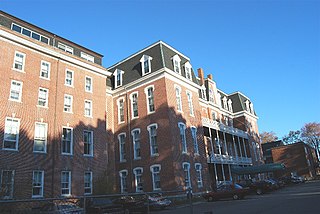
The Jesus Marie Convent is a historic former convent located at 138 St. Joseph's Street in Fall River, Massachusetts. It was built in 1887 and designed by local architect and parish member Louis G. Destremps, who also designed the nearby orphanage, school and church.

Cataract Engine Company No. 3 is a historic building at 116 Rock Street in Fall River, Massachusetts. It also served as the meeting hall of the Richard Borden GAR Post No. 46 of the Grand Army of the Republic. It is now occupied by a tobacco shop.

Corky Row Historic District is a historic district located in Fall River, Massachusetts bounded by Plymouth Avenue, Interstate-195 and Second Street. The district contains a large number of early multi-family mill tenement houses, along with the Davol Mills, the Tecumseh Mill No. 1 and several commercial properties.
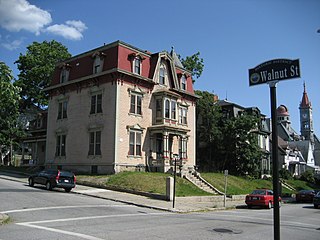
The Highlands Historic District is a historic district roughly bounded by June, Cherry, and Weetamoe Streets, Lincoln, Highland, President, North Main, and Hood Avenues in Fall River, Massachusetts. The district lies just north of the Lower Highlands Historic District.

The A. J. Borden Building is a historic commercial building located at 91–111 South Main Street in Fall River, Massachusetts.

The Ariadne J. and Mary A. Borden House is a historic house located at 92 Globe Street in Fall River, Massachusetts.

The Kendal Green Historic District is a rural residential district running along North Avenue in Weston, Massachusetts. It extends for about three-quarters of a mile, and includes elements representative of the development of Weston from a rural agricultural community to a residential suburb of Boston. In addition to a variety of predominantly residential and agricultural properties, it includes two formerly industrial sites important in Weston's history: the site of the Hobbs Tannery, and that of the Hook and Hastings Organ Factory. The district was listed on the National Register of Historic Places in 2000.

